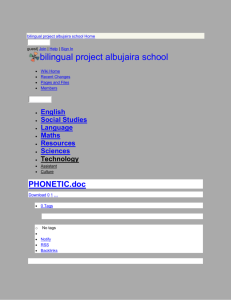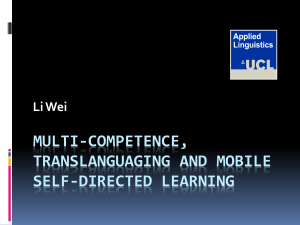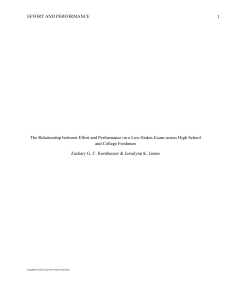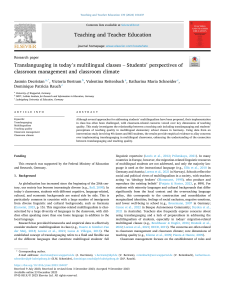Strategies for Translanguaging - CUNY
advertisement
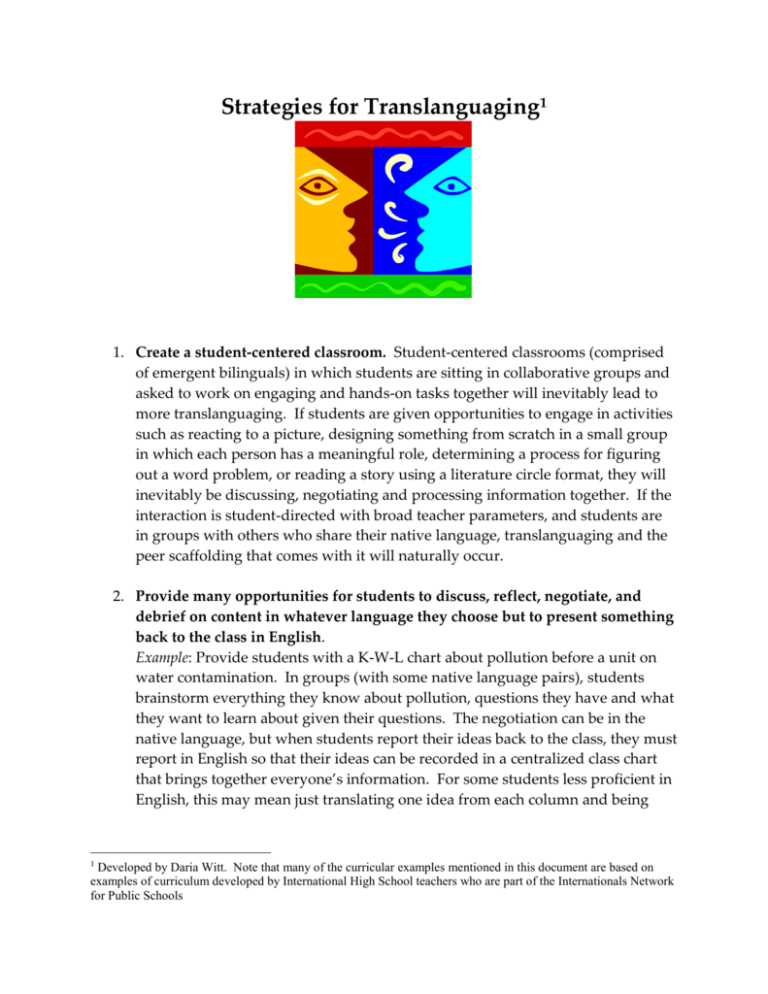
Strategies for Translanguaging1 1. Create a student-centered classroom. Student-centered classrooms (comprised of emergent bilinguals) in which students are sitting in collaborative groups and asked to work on engaging and hands-on tasks together will inevitably lead to more translanguaging. If students are given opportunities to engage in activities such as reacting to a picture, designing something from scratch in a small group in which each person has a meaningful role, determining a process for figuring out a word problem, or reading a story using a literature circle format, they will inevitably be discussing, negotiating and processing information together. If the interaction is student-directed with broad teacher parameters, and students are in groups with others who share their native language, translanguaging and the peer scaffolding that comes with it will naturally occur. 2. Provide many opportunities for students to discuss, reflect, negotiate, and debrief on content in whatever language they choose but to present something back to the class in English. Example: Provide students with a K-W-L chart about pollution before a unit on water contamination. In groups (with some native language pairs), students brainstorm everything they know about pollution, questions they have and what they want to learn about given their questions. The negotiation can be in the native language, but when students report their ideas back to the class, they must report in English so that their ideas can be recorded in a centralized class chart that brings together everyone’s information. For some students less proficient in English, this may mean just translating one idea from each column and being 1 Developed by Daria Witt. Note that many of the curricular examples mentioned in this document are based on examples of curriculum developed by International High School teachers who are part of the Internationals Network for Public Schools able to present that to the class. For others, they will be able to say anything from their group’s chart in English. 3. Have students present in one language and provide analysis in another Examples: Students create a Powerpoint written in English summarizing the highlights of their presentation. Their presentation is in their home language (or vice-versa). Students write a poem/song in their native language but provide analysis of their use of various literary devices in English. 4. Provide many opportunities for low-stakes writing in which students can use whatever language they wish (learning logs, journals, notes, reflections). This low-stakes writing in the native language can then be used as a scaffold to write something in English. 5. Structure the class so that students are asked to do frequent formal/informal presentations where there is a reason to use English, but allow and encourage students to use whatever language they wish for reading texts, negotiating process and ideas, and discussing. If a small group of students are preparing the “con” side of a debate about whether parents should be allowed to determine the sex of their children, encourage students to read pro and con arguments about the topic in their native language. If home language partners wish to work together to plan their arguments first in their native language, that can be useful. If the group’s only common language is English, they will need to plan collectively in English about who is making which argument, provide feedback on the strength of the arguments and anticipate rebuttals from their opponents, but some of the thinking and research can be done in the home language. Ultimately as the debate will be in front of the whole class, the arguments will need to be presented in English. 6. Design some projects/activities so that they culminate in a bilingual product. The development of a bilingual product inherently encourages translanguaging. Bilingual projects work best when there is an authentic reason to have students working in both languages as opposed to setting up a mere translation exercise. The following are examples of projects/activities that leverage students’ bilingualism and lead to a greater degree of higher order thinking than having students create the product in just English would allow. Create an election campaign advertisement for your community and one for a USborn group of people. After reading the United Nations Declaration of Human Rights in English and in your home language, design a bilingual brochure educating people in your home country and in the United States about human rights abuses happening in both places. Compare and contrast the ways in which human rights are protected/violated in both countries. Have students create a CD of songs (in any language) that represent their life. For each song they choose, students explain how particular aspects of that song (e.g. words, imagery, melody) represent something that happened to them. Native Language Voicethread. 12th grade students choose a poem written in their native language and create a Voicethread to teach 9th and 10th grade students about imagery. Students speak about the imagery of the poem in English so that students of all language backgrounds can understand. As part of this project, students also conduct an analysis of some of the grammatical and phonetic differences between their home language and English. 7. Purposefully group students so that home language support is available to those who need it. If the project requires students to be looking at home language resources together, it is best to have students sitting in a small group with at least one other person who shares his/her home language. Additionally, if there is a student who speaks very little English, he/she will be well served by sitting next to a student who is more proficient in English but shares the same home language. 8. Have students read a text in their home language before reading one on the same topic in English. This strategy can be used as a basic scaffold—reading about a topic in a language in which students are more comfortable will enable them to better understand a reading on the same topic in English. Additionally, it can be used as a powerful tool for analysis and engaging in higher order thinking. For example: Spanish speaking students studying the Age of Exploration could be given primary documents written by the Spaniards and other translations of documents written by indigenous people to compare their understanding of the same events. Students read native language newspaper accounts and American newspaper accounts about the same controversial issue and analyze and explain the similarities and differences in how that topic is reported in both places. Students then explain why they think the portrayal of the same topic in the United States differs from its portrayal in their home country. 9. In addition to encouraging students to use bilingual dictionaries, ensure that they are learning “anchor concepts” in both their home language and in English. It is not necessary to have students translate every word, but it is valuable for teachers to pause and have students translate the words that are most core to the topic being discussed. This not only builds biliteracy but also helps clarify misunderstandings and facilitate access to content (especially if students are familiar with that word in their home language). Additionally, for students whose home language is a romance language, having students do work on recognizing cognates and false cognates and with Greek and Latin roots (e.g. students brainstorm words in both their home language and in English that share the same root and look at the meanings of those words) can be very effective for building vocabulary.

